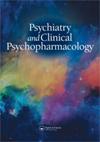Early effects of selective serotonin reuptake inhibitors (SSRIs) on cornea and lens density in patients with depression
IF 0.5
4区 医学
Q4 PHARMACOLOGY & PHARMACY
引用次数: 3
Abstract
ABSTRACT PURPOSE: To investigate the effects of SSRIs on cornea and lens density, intraocular pressure (IOP) and anterior chamber parameters, including anterior chamber volume (ACV), anterior chamber depth (ACD), corneal volume (CV) and central corneal thickness (CCT), in patients with depression during a three-month follow-up period. METHOD: In this prospective study, 31 total patients, who were prescribed SSRIs for depression, were recruited. Sertraline, 50 mg/daily, was given to ten patients; 11 received Escitalopram, 10 mg/daily; and ten were treated with Fluoxetine, 20 mg/daily. The parameters recorded were corneal density (CD), lens density (LD), IOP, ACV, ACD, CV and CCT at the start of treatment, as well as at one-week, one-month, and three-month follow-ups. RESULTS: The study revealed that there was no risk of cataract development from three months of SSRI intake. Significant decrease in ACD was recorded at the one-week follow up; however, after three months, this decrease was insignificant compared to the baseline. ACV, CV, CCT, CD and LD showed no significant alterations in any of the follow up examinations over the three-month period. IOP, however, significantly fell (a P value of 0.004). CONCLUSION: In this study, SSRI use does not seem to be associated with an increased risk of cataract or glaucoma or with changes in CD and LD. Long-term follow-up is necessary to determine the actual risk of cataract or glaucoma with SSRI intake.选择性血清素再摄取抑制剂(SSRIs)对抑郁症患者角膜和晶状体密度的早期影响
摘要:目的:研究SSRIs对抑郁症患者角膜和晶状体密度、眼压(IOP)和前房参数(包括前房体积(ACV)、前房深度(ACD)、角膜体积(CV)和角膜中央厚度(CCT)的影响。方法:在这项前瞻性研究中,共招募了31名服用SSRIs治疗抑郁症的患者。10例患者给予舍曲林50 mg/d;11例接受艾司西酞普兰10 mg/d;10例给予氟西汀20mg /d治疗。记录治疗开始时角膜密度(CD)、晶状体密度(LD)、IOP、ACV、ACD、CV和CCT以及随访1周、1个月和3个月时的参数。结果:研究显示,服用SSRI三个月后没有白内障发展的风险。在一周的随访中,ACD显著下降;然而,三个月后,与基线相比,这种下降并不显著。ACV、CV、CCT、CD和LD在三个月的随访检查中均无明显变化。IOP明显下降(P值为0.004)。结论:在本研究中,SSRI的使用似乎与白内障或青光眼的风险增加或CD和LD的变化无关。需要长期随访以确定SSRI摄入的白内障或青光眼的实际风险。
本文章由计算机程序翻译,如有差异,请以英文原文为准。
求助全文
约1分钟内获得全文
求助全文
来源期刊

Psychiatry and Clinical Psychopharmacology
Medicine-Psychiatry and Mental Health
CiteScore
1.00
自引率
14.30%
发文量
0
期刊介绍:
Psychiatry and Clinical Psychopharmacology aims to reach a national and international audience and will accept submissions from authors worldwide. It gives high priority to original studies of interest to clinicians and scientists in applied and basic neurosciences and related disciplines. Psychiatry and Clinical Psychopharmacology publishes high quality research targeted to specialists, residents and scientists in psychiatry, psychology, neurology, pharmacology, molecular biology, genetics, physiology, neurochemistry, and related sciences.
 求助内容:
求助内容: 应助结果提醒方式:
应助结果提醒方式:


